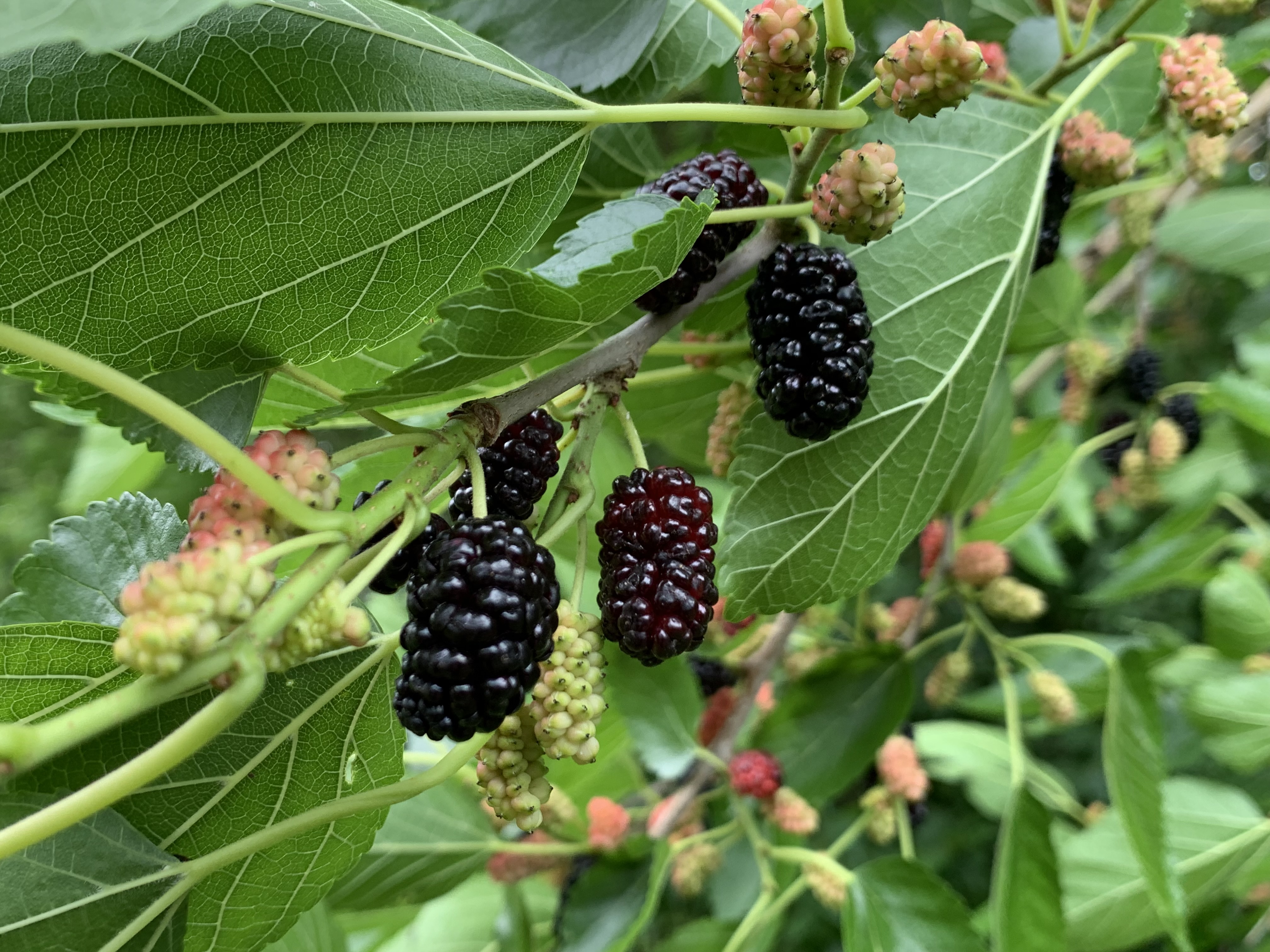Our mulberry trees are about ready for picking. The fruit is beautiful—cone-shaped, about an inch long berries with stems still attached and full of seeds. It is soft, sweet and fragile, a purple that will stain anything it comes in contact with. The flavor is delicate as well. They make lovely pies and cobblers.
When we were kids and the mulberries were ripe, our mother sent us to pick mulberries for a pie. Picking them is a long, hot and tedious endeavor for a child on a June day. It takes a long time to fill that bucket one berry at a time. Especially if you eat every other one you pick. If you put a sheet down on the ground and shake the tree, the berries will fall off onto the sheet and you can just pick them up by pooling them in the sheet and pouring them into your bucket. We didn’t use this technique as children. No doubt, part of the plan was to get a clean batch of mulberries, and part of it was to keep summer children busy. The pies were delicious, too.
The seeds of the mulberry are much softer than those of a raspberry, and almost pop when you chew them. The stems are also soft and edible, although a bit controversial. (Some people don’t like the ‘green’ taste of the stems.)
Mulberry trees, generally considered weed trees, grow all over Owl Acres. They spread like crazy, because the birds eat the berries and leave undigested seeds in purple splotches everywhere they go. The result is that we have several mature mulberry trees.

Red mulberry. Immature fruits red. Author photo
The red mulberry is native to Iowa. The white mulberry, on the other hand, is an import, and today, most of our mulberries are either white Chinese imports, or cross-bred white and native red.
Mulberry leaves, as everyone knows, are the food for silk worms. As early as the 1600s, the English king instructed colonists to plant mulberry trees and develop a silk industry in the new world. The native red mulberry turned out to be unsuitable for the silk worms because the leaves were too tough and hairy. So colonists and later Americans began importing the white mulberry from China to establish mulberry orchards. This effort had some early success in Georgia and a few other places, but was not robust enough even then to compete with the Chinese silk industry. In the early 1800s renewed efforts to establish a silk industry arose in Pennsylvania, Connecticut and other Eastern states when a new variety of white mulberry tree was introduced to the U.S. The idea was that women, children and the elderly as well as orphans and prisoners, could make themselves useful by managing the silk worms. Perhaps silk could replace whisky in the local economy as well? But tending silk worms and winding silk thread turned out to require more expertise and be more work than they bargained for. The worms had to be tended 24 hours a day, and skill and patience are required to unwind that cocoon into it’s one long continuous silk thread.
The biggest boom was not in the silk but in the trees. When this new variety of white mulberry was introduced to the United States in 1826, the promoters went crazy. In 1834, the price for a lot of 100 young trees was $3. By the end of the decade the price was up to $500. The inevitable crash came in 1839, ruining speculators and nursery owners alike. By 1844 the industry was dead. One writer dubbed the mulberry the “fruit of broken dreams.”
But dreams don’t die easily, and in the 1860s another effort, in California this time, was initiated to establish a silk industry. They planted acres and acres of trees and built Cocooneries to grow the silk worms. Thousands of silk worms chomping on mulberry leaves makes an amazingly loud noise as reported by people of the time. The Californians did produce raw silk, but the industry didn’t flourish there either. Limited U.S. silk production continued into the 20th century, but was eventually completely displaced by low-wage production in China and the introduction of synthetic fibers.
The mulberry did have a role in textile production at an earlier time. Native Americans harvested fibers from its bark to weave into fish nets, carry straps, belts, and similar items in pre-Columbian days. They also dried the fruit to use in making pemmican. Medicinal uses of the tree included drinking the sap to expel tape worms.
In China, Japan, Greece and even England, mulberry trees stand as symbols in art and culture for everything from star-crossed lovers to the connection between heaven and earth. In Iowa, however, they symbolize purple stains on streets and sidewalks, and messy, weed trees that need to be removed. Most people leave the berries to the birds, who are happy enough for the feast. But we, in a mood of harvesting the gifts of the land, are attempting to turn them into jam. We’ll see how it all turns out.
Photo by author

1 comment
You will have to let us know how the jam turns out.